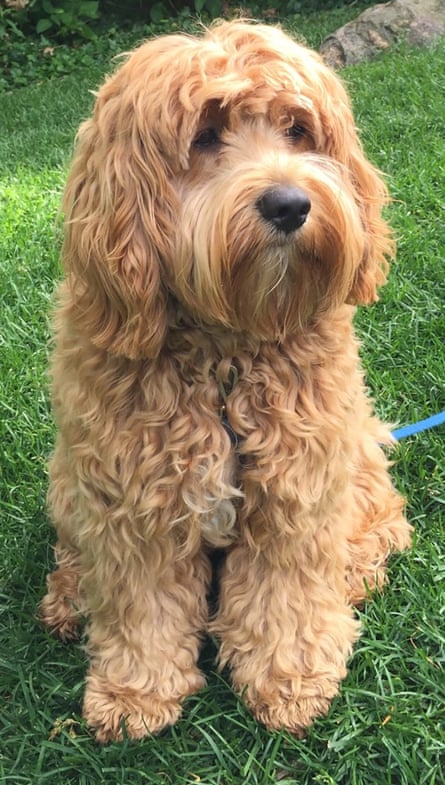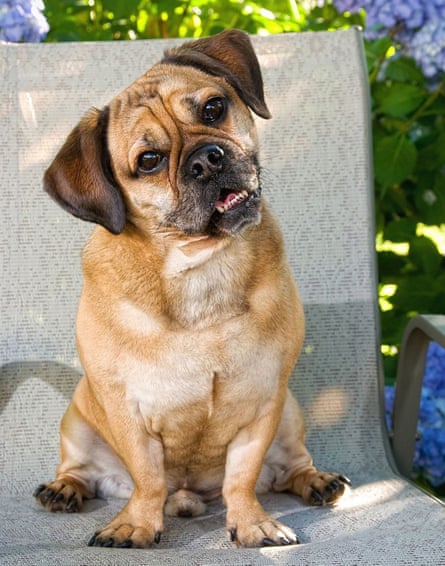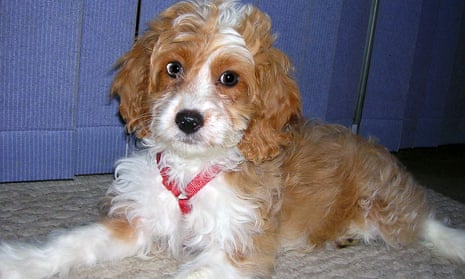It would take a hard heart not to melt at the beseeching brown eyes, soft, floppy caramel ears and white paws of Ollie, the dorgi. What’s a dorgi, you say? It’s a corgi crossed with a dachshund, who – like many of our contemporary four-legged friends – even has his own Instagram page.
This article includes content provided by Instagram. We ask for your permission before anything is loaded, as they may be using cookies and other technologies. To view this content, click 'Allow and continue'.
Someone bred two cute types of dog together to create a hybrid that’s even more adorable.
Cute factor isn’t the only reason to crossbreed. Breeders also mix dogs with desirable traits from different breeds. It started when Wally Conron joined a labrador and a poodle in the 1980s to create a guide dog that had the right temperament to escort a person with impaired vision but didn’t trigger allergic reactions.
Since the offspring from this mating were creatively dubbed “labradoodles”, the craze for designer mongrels with comical names has taken off. A survey by Petsure has found the number of designer crossbreed dogs being registered for insurance is on the rise in Australia. In the US, the American Canine Hybrid Club has registered 151 new hybrid breeds in the last decade, with 711 currently listed. Now we have bullypits (American pit bull terrier x bull dog) morkies (Maltese x yorkies), doxiepoos (dachshund x poodle), puggles (beagle x pug), dalmadoodles (dalmatian x poodle) and peke-a-pins (miniature pinscher x Pekingese). Conron is not happy about it.
He may have started a craze, but did his experiment to produce a hypoallergenic guide dog actually work?
According to the ABC, he sent hair and saliva samples from the labradoodle pups to their potential owner’s husband – who was allergic to dogs – in Hawaii to test if he reacted to them. Only one dog – Sultan – didn’t elicit any allergic symptoms, and he became the world’s first labradoodle guide dog.
As far as dogs that are marketed as hypoallergenic today, despite some breeders’ claims, research support is lacking. In fact, a 2012 study found no evidence of it when comparing “hypoallergenic” breeds including poodles and labradoodles with labrador retrievers and a control group. Anecdotally, though, people have reported less reactions to certain breeds. For instance, Dr Susan Hazel, lecturer in the University of Adelaide’s School of Animal and Veterinary Science, says her partner’s granddaughter was allergic to their previous dog but was fine when they opted for a poodle.

So, crossbreeding doesn’t guarantee a dog that is better for an allergic owner’s health – but what about the dogs themselves? It’s complicated.
Breeding purebreds can create the predictable, desirable traits associated with specific breeds – like the easy going and affectionate nature of goldens – but it can reduce genetic diversity and hence vitality and survival.
As a general rule, the offspring of two different species or breeds has greater genetic diversity, creating hybrid vigour – enhanced fertility, health and survival. However, when, say, a labradoodle, is produced, mating it with another labradoodle is comparable to joining two dogs from the same breed, and genetic diversity is once again reduced. To keep any hybrid vigour going, you need to keep mating the original two breeds.
But while the UK Kennel Club has been registering crossbreeds on its database for more than 50 years, record-keeping of their parentage has been lacking, making it difficult for scientists to assess their hybrid vigour.
“At the moment, when veterinarians or anybody else classifies a crossbred dog they just call it a crossbred dog,” says Frank Nicholas, emeritus professor of animal genetics at the University of Sydney. “The prediction is that there will be some [hybrid vigour], based on extrapolating from other species, but the evidence really is frustratingly lacking at the moment.”
Nicholas identified just three studies in dogs with clear data on their lineage. Two found enhanced behavioural outcomes when crossing a labrador with a golden retriever, producing a better guide dog, but one found a detrimental impact of mating a lab-golden cross with a poodle. The latter offspring had greater risk of a hereditary eye disease than their respective purebred lines. But due to tainted data overall, Nicholas stresses the importance of keeping careful records so canine hybrid vigour can be scrutinised.

Hybrid vigour is the “mirror image” of inbreeding depression, Nicholas writes, weakening of certain features as a result of excessive breeding with close relatives. Everyone carries deleterious genes that have mutated, and the more closely parents are related, the more likely these mutations are to appear and become more concentrated down the bloodline – like the European royal dynasties who proliferated haemophilia within their exclusive circles. That’s why it’s important for humans – and pedigree dogs like labradors and golden retrievers – to keep relations with sisters and cousins platonic.
Mind you, this isn’t a huge problem in dogs, according to Nicholas. “I mean there is some mating of close relatives,” he says, “but it’s not as big a deal as what it’s made out to be.”
A bigger problem is the sad fate of pedigrees bred for desirable qualities that damage their health, like the cute flat faces and short skulls of pugs, French bulldogs and Cavalier King Charles spaniels that constrict their breathing. This isn’t an issue for hybrid dogs that don’t have health-threatening breed standards – although if you cross a pug with a Frenchie you will likely end up with a dog that struggles to get air into its lungs.
Purebreds also have more than 300 genetically inherited defects. Fortunately, most of these come from autosomal recessive genes.
In purebred dogs, like in humans, both parents have to carry the recessive gene for their offspring to have a chance of inheriting the defect. So it’s highly improbable that hybrids will, although they’re not completely off the hook – some traits are carried by different breeds, such as hip dysplasia, a common disorder in labradors, goldens and other large dogs.

Crossbreeding does have its own dark side. Designer pooches with fancy names are a marketable commodity that ruthless breeders exploit. Hazel says they can even be more expensive than purebred dogs. And, “if people are in it just for the profit, the risk is the welfare of the animals”, she says.
Puppy farms – which usually service pet shops – are a heartbreaking manifestation of this, where dogs become breeding machines as soon as they reach reproductive age. According to the RSPCA, puppies and mums aren’t given enough food, water, grooming or exercise and miss out on affection and play. Added to unhygienic conditions like floors covered in faeces and urine, they end up mentally and physically sick, yet untreated. They are “literally being ‘bred to death’”.
Illegitimate breeders also don’t do the genetic testing required to ensure healthy offspring that don’t carry inherited diseases – whether pure- or cross-bred.
Even legitimate breeders can’t create the perfect dog. It’s not an exact science – there’s a huge pool of genes to draw from and there’s no guarantee what traits the offspring will have.
“It will be an individual case-by-case that some might be better, some might be worse,” Hazel says. “But then some pedigree dogs, depending on which breed it is and which breeder it is and how many diseases they’re screening for, some are healthier than others. So it’s hard to make a broad statement about any particular pure breed or any particular crossbreed.”
Importantly, dogs are sentient beings with personalities and needs, not designer accessories to show off. None will be perfect – like humans, there is huge variability, sometimes more so within than across breeds, according to Hazel. Anyone who takes a dog home needs to be willing to make time for their new companion and put in the hard yards to train and socialise it – for everyone’s benefit.

Some people in search of their four-legged soulmate rescue dogs from shelters and form rewarding lifelong bonds with them. It’s even said that “the best dog is a shelter dog”. But most importantly, the animal’s temperament and needs should match their owner’s, says Dr Janette Young from the University of South Australia. Many dogs in animal welfare shelters are energetic and medium-sized, she notes.
“So in fact, they’re not going to be appropriate for lots of people, and lots of situations like a small unit. If you’re not able to get out much yourself, you’re going to end up with a dog that could well end up back at the shelter because it’s just the wrong match.”
To help people make the right decision and navigate all the complexities, the RSPCA has a smart puppy and dog buyer’s guide, and Choice offers tips on avoiding unethical breeders. Hazel also cautions against buying dogs online.
Bearing that in mind, if you fall in love with an irresistible dorgi like Ollie, Nicholas says there’s nothing inherently wrong with looking for crossbred cuteness. Just don’t expect it to be hypoallergenic.

Comments (…)
Sign in or create your Guardian account to join the discussion